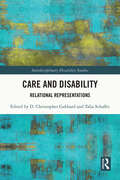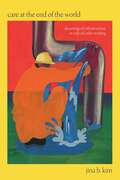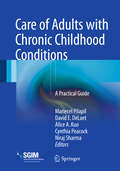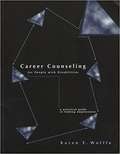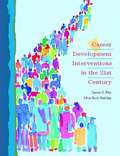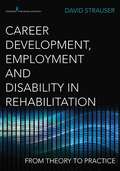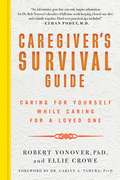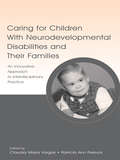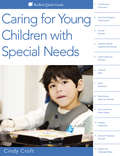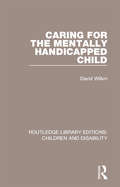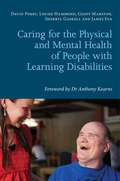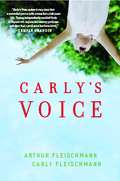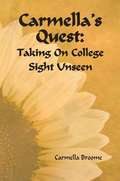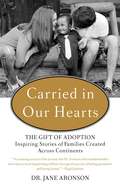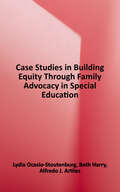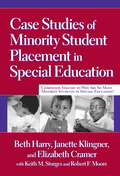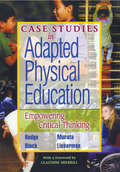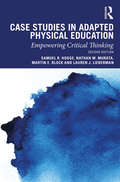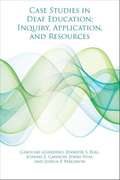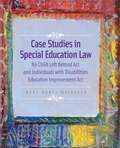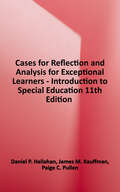- Table View
- List View
Care and Disability: Relational Representations (Interdisciplinary Disability Studies)
by Talia Schaffer D. Christopher GabbardCare and Disability is an edited collection offering critical perspectives on representations of care and disability, by emerging and established scholars across multiple periods, regions, and genres of literary studies.The authors demonstrate the range of fields in which care ethics can elucidate alternative cultural and social dynamics, including Indigenous, African American, and Asian texts, and historical eras that predate the modern medical profession. This collection is committed to drawing out the changing racial, gendered, classed, and sexual elements of care, emphasizing how care communities develop as alternatives to the heteronormative couple and the nuclear family. Drawing from the care ethics and disability theory, the work in this volume demonstrates the possibilities inherent in this new cutting-edge field.It will be of interest to all scholars and students of disability studies, care ethics, sociology, narrative medicine, Romanticism, eighteenth-century studies, transatlantic nineteenth-century studies, film, and contemporary race studies.
Care at the End of the World: Dreaming of Infrastructure in Crip-of-Color Writing
by Jina B. KimIn Care at the End of the World, Jina B. Kim develops what she calls crip-of-color critique, bringing a disability lens to bear on feminist- and queer-of-color literature in the aftermath of 1996 US welfare reform and the subsequent evisceration of social safety nets. She examines literature by contemporary feminist, queer, and disabled writers of color such as Jesmyn Ward, Octavia Butler, Karen Tei Yamashita, Samuel Delany, and Aurora Levins Morales, who each bring disability and dependency to the forefront of their literary freedom dreaming. Kim shows that in their writing, liberation does not take the shape of the unfettered individual or hinge on achieving independence. Instead, liberation emerges by recuperating dependency, cultivating radical interdependency, and recognizing the numerous support systems upon which survival depends. At the same time, Kim demonstrates how theories and narratives of disability can intervene into state-authored myths of resource parasitism, such as the welfare queen. In so doing, she highlights the alternate structures of care these writers envision and their dreams of life organized around reciprocity and mutual support.Duke University Press Scholars of Color First Book Award
Care of Adults with Chronic Childhood Conditions: A Practical Guide
by David E. Delaet Mariecel Pilapil Alice A. Kuo Cynthia Peacock Niraj SharmaThis book addresses the unique healthcare needs of adults with chronic childhood illnesses. It presents a model of primary and secondary prevention for emerging adulthood--primary prevention in which all young adults are screened for high-risk behaviors and health needs and secondary prevention in which young adults with chronic childhood conditions are optimized through coordinated care, connections to community resources and social/family support. This book is organized in five parts. Part I provides a detailed overview of the health care transition from pediatrics to adult medicine from both a policy and practice perspective. In Part II, the concept of emerging adulthood as a developmental period is explored and strategies for providing improved comprehensive care for this age group are discussed. Part III reviews specific chronic childhood conditions, such as attention-deficit/hyperactivity disorder, autism, cystic fibrosis, and diabetes mellitus, and offers clinical cases and summary reports that can be used as a quick guides to each condition. In Part IV, additional clinical considerations that are not necessarily condition-specific but are highly relevant to the care of young adults with chronic childhood conditions are examined. Part V describes the socio-legal issues involved in caring for this population. Care of Adults with Chronic Childhood Conditions provides primary care providers with a new framework for the care of young adults and identifies opportunities to influence patient health outcomes over a life trajectory.
Career Counseling for People with Disabilities: A Practical Guide to Finding Employment
by Karen E. WolffeA text for use in courses in rehabilitation counseling, educational psychology, and special education, also useful for practicing counselors and educators. Section I introduces the field, types of clients, theories, and legislation. Section II details five key career counseling content areas, and Section III addresses disability- specific considerations. Section IV describes local, state, and national resources and lists helpful phone numbers. Includes chapter-opening vignettes and application activities, and five appendices of reproducible handouts to use with clients. Annotation copyrighted by Book News, Inc., Portland, OR
Career Development Interventions in the 21st Century
by Joann Harris-Bowlsbey Spencer G. NilesThis book presents strategies and suggestions for teaching career development as well as strategies for helping with career choices. Includes case studies and a bibliography.
Career Development, Employment, and Disability in Rehabilitation: From Theory to Practice
by David Strauser<p>This text provides, from a rehabilitation perspective, comprehensive coverage of the dominant theories and techniques related to the occupational development, vocational behavior, and the organizational factors that impact the career development and employment of individuals with disabilities. It is designed for the CORE-mandated required course on employment and career development for the Master's Degree in rehabilitation counseling and for Licensed Professional Counselor certification. As the only book in rehabilitation and counseling that broadly addresses career development and employment of individuals with disabilities, it is a major contribution to the literature. <p>Topics covered include major constructs in career development and employment of disabled individuals, theoretical foundations, occupational assessment, information and evaluation, intervention strategies, and populations and settings. To facilitate learning and promote application of theories and techniques, each chapter includes chapter objectives, discussion and review questions, and case studies. An instructor's manual is also included.</p>
Career Perspectives: Interviews with Blind and Visually Impaired Professionals
by Marie AttmoreInterviews and advice from blind and visually impaired professionals about education and breaking into the job market.
Career Planning
by Spencer G. Niles Thomas F. Harrington Garbette A. M. GarrawayNIMAC-sourced textbook
Career Success of Disabled High-flyers
by Sonali Shah'Disabled people can be seen pejoratively as a homogenous group that are typically "weak" and "needy" and thus unable to undertake the rigours of professional care work. Shah also notes that disabled people are often wrongly assumed to have a high level of absences from work and to be thought generally less capable. Such discriminatory attitudes must be set aside. Disabled people are first and foremost people and will have a contribution to make to the professions, not least because of the invaluable problem solving skills they acquire in having to overcome everyday problems that many of us take for granted. Shah's book will hopefully provide inspiration for disabled professional staff, students and service users and show that equality and success are achievable for disabled people.' - Journal of Interprofessional Care 'Practitioners working in many settings with people with dementia are likely to find this book presents new ideas but it would also be relevant to those working in rehabilitation services who do not, as yet, see people with dementia as key "clients".' - Journal of Interprofessional Care 'They are actors, clerics, managers, journalists, financial advisors, instructors, athletes and developers of athletes, and educators. One is a member of parliament. Another is a dancer. Shah (sociology and social policy, Nottingham U.) interviewed 31 successful people with disabilities and found their influences, motivations, goals, and perceptions varied from individual to individual, and depended on family expectations, education, individual personalities, and career choices. She also found they differed in what they perceived to be success, how well their employers treated them, and how they handled failure. Shah's conclusions include the ideas that career development is important, that those who seek suitable role models and coping strategies, and that integration of schools should include everyone.' - Book News 'By examining subjective factors like ambition (determination, response to disability and personal definitions of success) alongside objective measures (educational achievement, social status and financial success), Shah provides a useful framework for us to look at how all disabled people can be integrated into mainstream societyâ?¦ Instructive for anyone who works with disabled people in education, employment and society in general, this book is a through piece of social research.' - Community Care 'This is a detailed and thought-provoking book that looks at the influences on, and the experiences of 31 successful disabled adults. It is the product of a PhD research project and the author herself is a disabled personâ?¦ Career Success of Disabled High-Flyers should be used to inform educational and employment policy and practice. It provides role models for aspiring young people and other disabled adults and I recommend this book to teachers, guidance providers, employers and in fact anyone who is looking for an intelligent and well researched account of the experience of disabled people and factors relating to their success.' - Newscheck Career Success of Disabled High-Flyers challenges the assumption that disabled employees are a homogenous group and discusses important questions such as: What is disability? How do people with physical impairments define success? Does gender impact in the same way on disabled and non-disabled people's careers? Drawing on in-depth case studies of thirty-one disabled adults who have been successful in their careers, this book suggests that individual traits and patterns of behaviour are key factors in career success, and shows that it is often society rather than impairment that hinders professional progression. Providing role models and valuable insights for young career-minded disabled people, it will also help inform policy and practice in education and training about disability and equality in schools, employment, and society in general. This book is a must-read, not only for people with disabilities, but for teachers, policy-makers, employers and anyone wi...
Caregiver's Survival Guide: Caring for Yourself While Caring for a Loved One
by Ellie CroweCaregiver's Survival Guide is based on Dr. Robert Yonover's personal experiences. While struggling to become a successful scientist and inventor, he also was primary caregiver for his paralyzed wife for more than twenty years and raised their two children. Yonover takes you into the throes of his life as a caregiver, husband, and father, offering guidance and hope through his story. He provides advice on: Dealing with heavy news Handling day-to-day challenges Holding on to the foundation of your relationship Taking stock of finances Adapting and enjoying life Staying sane Maintaining a social life Fighting for your rights Through Caregiver's Survival Guide, Dr. Yonover will equip other caregivers who face similar physical, mental, social, and financial challenges with tips and guidelines from his own experiences and other experts to help make their situation survivable.
Caring for Children With Neurodevelopmental Disabilities and Their Families: An Innovative Approach to Interdisciplinary Practice
by Claudia María VargasChildren with neurodevelopmental disabilities such as mental retardation or autism present multiple challenges to their families, health care providers, and teachers. Professionals consulted by desperate parents often see the problems from their own angle only and diagnosis and intervention efforts wind up fragmented and ineffective. This book presents a model multidisciplinary approach to care--family-centered and collaborative--that has proven effective in practice. A pillar of the approach is recognition of the importance of performing culturally competent assessment and adjusting service delivery so that is responsive to cultural differences. Detailed case stories illuminate the ways in which the approach can help children with different backgrounds and different disabilities. Most chapters include study questions, lists of resources, and glossaries to facilitate easy comprehension by professionals with different backgrounds--in special education, communication sciences, and disorders, clinical and counseling psychology, neuropsychology and psychiatry, social work, pediatrics--and program administrators as well as students, trainees and educated parents. Caring for Children With Neurodevelopmental Disabilities and Their Families constitutes a crucial new resource for all those professionally and personally concerned with these children.
Caring for Young Children with Special Needs
by Cindy CroftThis easy-to-use guide gives you a quick overview on many topics related to working with young children with special needs. Learn about inclusion in early childhood programs and disability law, as well as typical vs. atypical development. The quick guide also covers several specific disabilities/special needs and provides definitions, common characteristics, and practical strategies for adaptation.Cindy Croft is the director of the Center for Inclusive Child Care at Concordia University and on faculty for several university education programs. She has her MA in Education and has worked in the field of early childhood for over twenty years.
Caring for the Mentally Handicapped Child (Routledge Library Editions: Children and Disability #12)
by David WilkinFirst published in 1979, this book concerns itself primarily with the mothers of mentally handicapped children. It discusses the problems of assistance that they may have experienced from their families, the community, or the available services. Whilst arguing for far more support for mothers when they are the main carer, this book also suggests reasons why some families are more easily able to cope with the problems of caring for severely handicapped children. <P><P>This study is based on research that was conducted for and funded by the Department of Health and Social Security between 1973 and 1976.
Caring for the Physical and Mental Health of People with Learning Disabilities
by David Perry Louise Hammond Sherryl Gaskell James Eva Anthony Kearns Elin Davis Geoff MarstonPeople with learning disabilities are at greater risk of physical and psychiatric illness than the population at large, but their health needs are often not adequately supported. This book is a practical guide for those caring for people with learning disabilities living in community settings. It is designed to help the carers to better understand what the service users' health needs may be, how to recognise problems, and how to meet their needs. Chapter topics include physical health issues such as epilepsy, common health problems and diet and well-being; mental health issues such as dementia, depression, bipolar disorder and anxiety; and information related to common issues such as sleep and swallowing problems. The book also includes advice on screening programmes and health checks. Written in an accessible and straightforward style, this book will be an invaluable guide for anyone caring for someone with a learning disability, including social carers, health facilitators, community nurses and family carers.
Carly's Voice: Breaking Through Autism
by Arthur FleischmannAt the age of two, Carly Fleischmann was diagnosed with severe autism and an oral motor condition that prevented her from speaking. Doctors predicted that she would never intellectually develop beyond the abilities of a small child. Although she made some progress after years of intensive behavioral and communication therapy, Carly remained largely unreachable. Then, at the age of ten, she had a breakthrough. While working with her devoted therapists Howie and Barb, Carly reached over to their laptop and typed in "HELP TEETH HURT," much to everyone's astonishment. This was the beginning of Carly's journey toward self-realization. Although Carly still struggles with all the symptoms of autism, which she describes with uncanny accuracy and detail, she now has regular, witty, and profound conversations on the computer with her family, her therapists, and the many thousands of people who follow her via her blog, Facebook, and Twitter. In Carly's Voice, her father, Arthur Fleischmann, blends Carly's own words with his story of getting to know his remarkable daughter. One of the first books to explore firsthand the challenges of living with autism, it brings readers inside a once-secret world and in the company of an inspiring young woman who has found her voice and her mission.
Carly's Voice: Breaking Through Autism
by Arthur FleischmannIn this international bestseller, father and advocate for Autism awareness Arthur Fleischmann blends his daughter Carly's own words with his story of getting to know his remarkable daughter--after years of believing that she was unable to understand or communicate with him.At the age of two, Carly Fleischmann was diagnosed with severe autism and an oral motor condition that prevented her from speaking. Doctors predicted that she would never intellectually develop beyond the abilities of a small child. Carly remained largely unreachable through the years. Then, at the age of ten, she had a breakthrough. While working with her devoted therapists, Carly reached over to their laptop and typed "HELP TEETH HURT," much to everyone's astonishment. Although Carly still struggles with all the symptoms of autism, she now has regular, witty, and profound conversations on the computer with her family and her many thousands of supporters online. One of the first books to explore firsthand the challenges of living with autism, Carly's Voice brings readers inside a once-secret world in the company of an inspiring young woman who has found her voice and her mission
Carmella's Quest: Taking on College Sight Unseen
by Carmella BroomeThe author, who is blind, describes her years at North Greenville College.
Carried in Our Hearts
by Dr Jane Aronson"My mommy didn't carry me in her tummy, she carried me in her heart." Bailey, a 5-years old who was adopted from China. Her story is included in this book. According to People magazine, parents from all over the country seek adoption expert and Worldwide Orphans Foundation founder Dr. Jane Aronson's help "as if consulting a master detective." Angelina Jolie praised Dr. Aronson's "drive and ambition to help children dream" (Elle). Indeed, over the course of the past three decades, Dr. Aronson has touched the lives of thousands of adopted children from around the world and in this inspiring book she presents moving first-person testimonies from parents (and a few children themselves) whose lives have been blessed by adoption. Divided into thematic sections--such as "The Decision," "The Journey," and "The Moment We Met")--each prefaced by Dr. Aronson, this book introduces readers to Claude Knobler, a writer from Los Angeles whose journey to Ethiopia to adopt his son led to an unexpectedly moving encounter with the boy's courageous birthmother; actor Mary Louise-Parker whose older adopted son's bond with her newly adopted baby daughter was deep and unwavering from the instant the two children met; and Lynn Danzker, an entrepreneur who set off alone to adopt her son, Cole, and in the process, met and married her husband. The authors of these testimonies range from doctors to filmmakers, from financial consultants to celebrities--all of them bound by their moving and transformative experience as adoptive parents.
Case Studies In Building Equity Through Family Advocacy In Special Education: A Companion Volume To Meeting Families Where They Are
by Beth Harry Lydia Ocasio-StoutenburgYou've read the history and the background, now meet the families! This companion book to Meeting Families Where They Are traces the advocacy journeys of 12 caregivers across a range of racial, ethnic, social, disability, economic, and family identities. The stories reflect the unique lives, histories, and needs of each family, as well as the different approaches they employ to meet the needs of their children. Caregivers indicate when they began to advocate; describe how they continue their efforts across schools, medical offices, therapies, communities, and virtual spaces; and discuss how they adapt to changing social and health climates and educational delivery modes. They also share their collective wisdom to assist other parents who are new to the advocacy platform or are feeling discouraged with the process. This is a must-read for family members, teachers, administrators, healthcare personnel, and everyone invested in creating a culture of respect, love, and understanding. Book Features: - Emphasizes how families have resisted the deficit-based view of their children while still utilizing support systems. - Identifies gaps and challenges across multiple systems, as well as "what's working." - Incorporates the fields of special education and disability studies in education. - Uses the framework of DisCrit to explore how disability and other social identities operate in tandem, examining concepts such as power, access, privilege, and barriers. - Positions caregivers as experts in their children's lives, illustrating how they advocate for their children, teens, and young adults. - Takes a deep dive into the nuances of generational, cultural, organizational, and geographical factors that impact caregivers' advocacy. - Resists approaches that typically involve professionals dictating what families need, centering instead on a collaborative model that includes families and professionals.
Case Studies Of Minority Student Placement In Special Education
by Beth Harry Janette Klingner Donald Klingner Keith M. Sturges Elizabeth Cramer Robert F. MooreThis book features vivid case studies that bring to life real children, school personnel, and family members from the bestselling book Why Are So Many Minority Students in Special Education? Once again addressing the disproportionate placement of minority students in special education programs, this new book includes the voices and perspectives of all stakeholders to show the tremendous complexity of the issues and the dilemmas faced by professionals, family members, and children. Challenging questions and scenarios are offered at the end of each case study to provide thoughtful follow-up activities and topics for further study. This collection of cases can be used—on its own or as a companion to the main volume—in elementary and special education courses and professional development workshops.
Case Studies in Adapted Physical Education: Empowering Critical Thinking
by Martin Block Lauren Lieberman Nathan Murata Samuel HodgeThe case studies in this book provide readers with opportunities to think critically about real-life situations that arise when working with children with varied abilities and disabilities, as well as opportunities to question and explore and to empower themselves in the process. The case scenarios illustrate actual experiences faced by a diverse group of general and adapted physical educators representing various contexts from self-contained APE classes and inclusive GPE (elementary, middle, and high school; urban, rural, and suburban) to youth sports, community recreation, and health club settings. When reading the book, pre-service and in-service teachers will be exposed to the issues facing physical educators as changes in federal law further mandate the inclusion of students with disabilities in general physical education classes and after-school sports. Identifying with the situations and characters in the cases will encourage readers to explore such issues as diversity and disability, attitude and ethics, behavior management and conflict resolution, and inclusion strategies. Questions following each case prompt readers to identify the critical issues and how the physical education professionals dealt with those issues, and then determine whether they would have handled the issues in the same way. Analyzing and discussing the cases will enable readers to formulate strategies for dealing with related issues and better prepare them to provide safe, satisfying, and successful physical activity experiences to individuals with varied abilities.
Case Studies in Adapted Physical Education: Empowering Critical Thinking
by Martin Block Lauren Lieberman Nathan Murata Samuel HodgeCovering self-contained adapted physical education classes, general physical education programs, and youth sports and community recreation, this book presents a series of case studies of teaching individuals of varied ability and disability in physicalactivity settings. Outlining realistic scenarios, it encourages an interactive, problem-solving teaching and learning style and the development of critical thinking skills. Now in a fully revised and updated second edition, the book covers a wide range of different professional issues, themes, disabilities, and conditions, from assessment and behavior management processes to working with students with intellectual disabilities, motor difficulties, chronic illness, or obesity. Each case study includes questions that challenge the reader to ref lect on the practical issues involved and how to build inclusive teaching strategies. This book is valuable reading for all physical education students, teacher candidates, and novice and experienced teachers looking to deepen their understanding of adapted physical education and to improve their professional practice. It is an essential companion to any adapted physical education or physical activity course.
Case Studies in Deaf Education: Inquiry, Application, and Resources
by Caroline Guardino Jennifer S. Beal Joanna E. Cannon Jenna Voss Jessica P. BergeronCase Studies in Deaf Education provides comprehensive materials that will prepare prospective teachers to work with the diverse spectrum of students who are d/Deaf and hard of hearing (d/Dhh) and empower them to better understand these complex and unique learners. The text presents an extensive series of case studies that are balanced and unbiased in both language and instructional approaches and that encourage readers to use background details, academic data, and evidence-based practices to make informed educational decisions. The authors address the diversity of d/Dhh students by examining a multitude of learner characteristics that influence communication and educational services. These characteristics and their interactions include a student’s background experiences, language and communication mode (sign and/or listening and spoken language), language and academic proficiency levels, use of assistive hearing devices (hearing aids or cochlear implants), and family dynamics. The case studies are supported with authentic supplemental materials, such as audiograms and Individualized Educational Plans, and are accompanied by discussion questions, activities, resource lists, and a glossary of essential terms. Case Studies in Deaf Education will help teachers and allied professionals develop the knowledge and skills to use a collaborative, problem-solving process that leads to the provision of quality, effective services for students who are d/Dhh. An electronic instructor’s manual accompanies this text and will be available upon publication.
Case Studies in Special Education Law: No Child Left Behind Act and Individuals with Disabilities Education Improvement Act
by Mary Konya WeishaarEighteen case studies capture important issues within the IDEA and NCLB legislations and provide real-life context for studying special education and the law. Topics include accountability; participation in high stakes assessment; the referral and pre-referral process; zero reject, child find and discipline; nondiscriminatory assessment; appropriate education and IEPs; least restrictive environment; due process; and parent participation. Readers will see a variety of students, issues and interventions (both best practice and less than best practice) and have opportunities to examine the legal issues and other issues behind each case.
Cases for Reflection and Analysis for Exceptional Learners - An Introduction to Special Education, Eleventh Edition
by Daniel P. Hallahan James M. Kauffman Paige C. PullenThis book provides a comprehensive, case-based approach to understanding the diverse needs of exceptional learners. Using real-life scenarios, it encourages readers to reflect on and analyze the challenges and strategies involved in special education. The text covers key topics in the field, including legal aspects, classroom accommodations, individualized education programs (IEPs), and methods for fostering inclusive environments. Designed for both students and educators, it aims to deepen understanding of the complexities involved in supporting learners with disabilities, offering practical insights and fostering critical thinking in addressing their unique needs.
